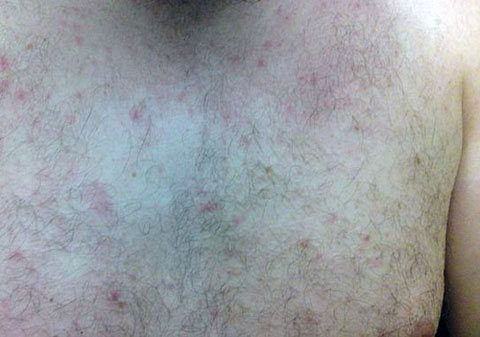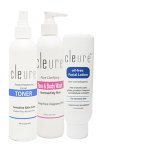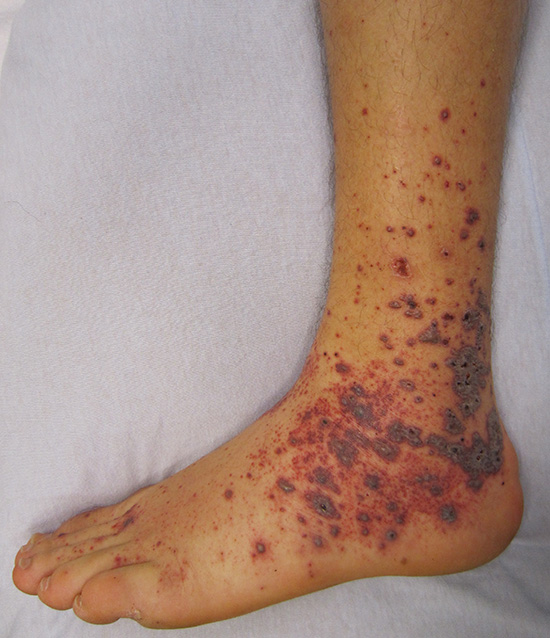Heat Rash
Heat Rash Causes, Symptoms and Treatments
Heat rash or miliaria, occurs when the body's natural ability to sweat and cool the body is hindered. Our skin automatically reacts to outside environmental factors in order to protect us from potentially harmful things like pollution, viruses, and even UV rays from the sun.
How Does It Happen?
Given that our skin is our largest organ, it is a pretty important barrier against the world if you will, so how does it react when that natural reaction to an unhealthy environment is stopped in its tracks?
You know right away the answer to that question if you've ever been out in the hot weather and have developed an uncomfortable rash. This type of skin rash occurs when the sweat glands are stopped up or clogged, which means the sweat can't reach the skin's surface in order to properly cool the body's inside temperature.
Symptoms

The symptoms vary depending on the area of the body that is affected and how deep beneath the skin surface the sweat glands are blocked. You could see small bubbles on the skin surface, medium size red blisters, or larger blisters along with a red, itchy rash. The larger blisters often feel firmer than the others and can cause the affected area to fee very sore in addition to itchy.
The rash can occur anywhere on the body but typically appears on the insides of the arms, upper chest, armpits, abdomen, groin, underneath breasts, neck, or back.
Who Suffers and Why?
Adults and children both can develop this type of skin rash. Some of the causes include:
- Bundling up during colder months in heavy blankets or sheets or in the case of infants, too much clothing during hot weather
- Folds of skin on the body preventing proper air circulation
- Illness – people bundle when they have a fever
- Some medications
- Intense exercise
- Bedridden elderly people can develop it if they're not moved periodically
- Lotion applications that are too thick
- Wearing clothing that is too tight or restricting
- Infants can develop the rash simply because their sweat glands are not yet fully developed
- Geographical location – hot, humid areas of the world
How Long Does It Last?
The duration of this rash varies considerably depending on your situation, but it can last up to 10 days in some cases. The key is to keep your skin dry and cool for several days in a row and that's when you'll see relief from your symptoms and the appearance of the rash will diminish or disappear altogether.
Prickly Heat Rash
A more intense version of the basic rash associated with heat, the prickly version is aptly named due to the prickly sensation or stinging sensation you feel on the skin once the rash and bubbles appear. Toddlers and infants are more prone to this type of rash, but adults who are extremely athletic and active can also get it.
Symptoms are much like the ones listed above except with the addition of the itchy, prickly, stinging sensations that accompany this rash.
Baby Heat Rash
It's a bit disconcerting to a parent when they discover a rash on their little one, but the good news is that this type of rash is not contagious and should only last a few days with the proper care.
Babies can have those sweet extra folds of skin that are fun to squeeze, but can also cause the sweat glands to clog up and not cool the body properly. This type of rash can show up on the baby's chest, legs, arms, face, and back.
Taking your baby out in the warm weather is fine as long as you dress him or her in lightweight cool clothing and keep them out of hot car seats or strollers for extended periods of time.
Heat Rash Pimples
Small red pimples or bumps may appear on your skin after you've been outside in the heat for a while or have been exercising intensely. They're very tiny, but can sting, burn, or otherwise be uncomfortable.
Some people say that the pimples feel hot when touched and others also experience redness of the skin underneath the pimples. They can show up on the face, inside the elbow, under breasts, chest, back, neck, or groin area.
Heat Rash Pictures
We will be adding pictures very soon so you can get a look at what this type of rash looks like on infants, toddlers, and adults.
Heat Rash Treatment
A physician can diagnose a rash caused by heat simply with a visual exam. He then may prescribe a topical lotion such as calamine lotion, hydrocortisone spray, or a talc powder like Triclosan to help with the symptoms and appearance of the rash. It's possible that in severe cases, topical steroids may also be prescribed.
Warning: Independent research indicates that Triclosan is a potentially dangerous substance found in many health and beauty products. When these products are combined with tap water or warm water, chloroform is sometimes produced. It's also been shown to be toxic to organs of the body, hard on the immune system, and could cause birth defects, so it should be avoided whenever possible.
Home Remedies
- Application of pure Vitamin E oil to the affected area
- Allow your skin to air dry following a bath or shower instead of using a towel
- Wear loose clothing that is made from breathable fabrics – focus on ones that wick away moisture from the skin
- Got watermelon? Rub the inside of the rind over the affected area.
- Sprinkle cornstarch over the rash
- Stay inside cool buildings whenever possible during hot weather
- Limit intense exercise
- Apply pure aloe Vera gel to area
- Use only light lotions with natural ingredients – heavier ointments and creams can hinder the skin's evaporation process
- Increase your Vitamin C intake – hinders the itchiness
Skin rashes aren't any fun, but rashes caused by hot temperatures, restrictive clothing, a warm living environment, and high levels of physical activity can be treated and cleared quickly, usually within 3 to 10 days. It's all about knowing how to be good to your skin!
Home > Heat Rash









New! Comments
Share your thoughts about what you just read! Leave me a comment in the box below.